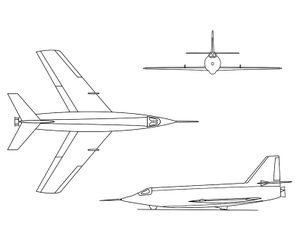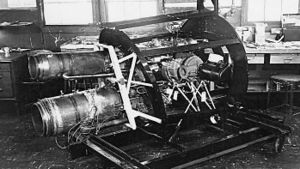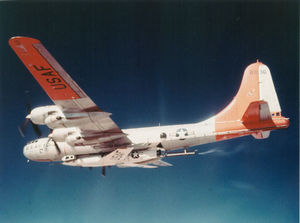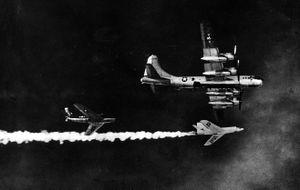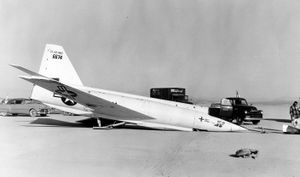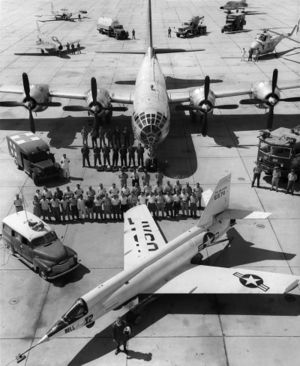First-Hand:The X-2 - Chapter 8 of The Experimental Research Airplanes and the Sound Barrier
By David L. Boslaugh, CAPT USN, Retired
Inception of the X-2 Project
The genesis of the swept wing X-2 research airplane lies in American aeronautical experts’ visits to Germany soon after the end of World War II where they saw the extensive research German engineers had done on swept wing aircraft. Some swept wing research had also been done in US during World War II, but was only of academic interest because engineers could see no real application at the time. It had been found in wind tunnel tests that swept wings not only delayed the onset of compressibility problems to a higher speed, but also offered less drag at transonic and supersonic speeds. Almost simultaneously with the preliminary design of the straight wing X-1 series, there were thoughts of a swept wing version of the X-1 because it could now be seen that it would be worthwhile to methodically investigate the expected advantages of swept wings. The basic X-1s were designed with straight wings primarily because of the need to improve the transonic performance of existing military fighters, all of which had straight wings. [39, p.35]
A swept wing version of the X-1 did not come to pass, however, because it was found that the X-1 fuselage could not accommodate a swept wing without considerable rework; a new basic structure design would be needed. With NACA concurrence, the Air Force in October 1945 tasked the X-1 builder, Bell Aircraft Corporation to start on the preliminary design of a new swept wing research airplane. It must be recalled that at this time the Navy/NACA/Douglas team had not yet come up with the plan for a swept wing successor to the straight wing Douglas D-558-I research airplane. On 3 July 1947 the Air Force contracted with Bell to design, build, and demonstrate two swept wing supersonic research airplanes as a follow-on to the three X-1s. The new planes would be designated X-2, and their flight goals would be Mach 3.5 speed and 125,000 feet altitude. There was concern that at speeds in the Mach 3 range, structural heating due to air friction could weaken airframes, so aerodynamic heating studies as well as stability and control would be important research areas. It is significant to realize that in 1945 when Bell Aircraft was tasked to begin the Mach 3-capable X-2 design, the first of the X-1s had not yet flown, and no one was sure that supersonic flight could even be achieved. This was forward thinking indeed. [39, p.35] [30, p.4]
Design
The most notable X-2 design feature would be the 40 degree swept wing. The NACA-designed wing airfoil would be two semicircular arcs with ten percent thickness-to-chord ratio, and the top and bottom skins would be formed from sheets of stainless steel tapered from root-to-tip. The ailerons would be unusual in that they would have blunt trailing edges for better control effectiveness and also to alleviate aileron flutter and buzz. The tail surfaces would also be made of stainless steel. The craft would have an all moving horizontal stabilizer but would have a conventional vertical stabilizer and rudder arrangement. The rudder would be moved by the pilot with a conventional cable system and rudder pedals, however the ailerons and “stabilator” would be positioned by irreversible pilot-actuated hydraulic control systems. Pilot’s control feel in roll and pitch would be by springs at the bottom of the control stick. At speeds above Mach 2, shock waves impacting the rudder would feed more force back to the pilot than he could manually control, so he was given a rudder lock to keep the rudder in neutral for high speed flight. [36, pp.9-10]
In contrast to the X-1 and Douglas D-558 research airplanes, whose structures were designed to withstand 18 gs, the X-2 would be stressed only to the normal fighter plane 12 g limit. Because of the expected effects of aerodynamic heating, the fuselage would also be made from material that retained strength at high temperatures, in this case K-Monel metal, a copper-nickel alloy, would make up the fuselage. The X-2 would be the first airplane to use this material, and there would be many fabrication challenges, as well as providing a valuable learning experience for the aircraft industry. [39, p.42]
As with the X-1s and D-558-II series aircraft, the X-2 would be rocket propelled and air [30, p.2] dropped, but would use a newly developed, more powerful, XLR-25 rocket engine. Propellant would be fed to the engine by a turbo pump powered by a mixture of water/alcohol and liquid oxygen generating high pressure steam rather than pressurized propellant tanks. This meant the tanks would not have to be pressurized spheroids, but could rather fit the form of, and be integral with the fuselage skin. This would allow considerable more propellant volume in the fuselage than the X-1s. The alcohol propellant tank would be located over the wing, and there would be two liquid oxygen tanks, one forward and one aft of the alcohol tank. For emergency jettison, the propellants would be expelled by relatively low pressure nitrogen gas. As with the other research airplanes NACA would install a comprehensive instrumentation suite to be located in the volume below the wing. This was the volume taken up by the main landing gear in the X-1s, so there was no internal space for retracting the main gear. Instead, the X-2 would use an extensible steel landing skid that would be retracted flush with the underside skin in flight. There would be an unsteerable nose wheel that would be lowered by a combination of gravity and compressed shock strut force. Similar to the X-1s, the X-2 would have tunnels along fuselage top and bottom to house piping, wiring and control cables. [30, pp.4-5] [39, pp.38-43]
The X-2 would have a separable nose escape capsule similar to the D-558-II Skyrocket series. However, instead of the pilot egress out of the back of the capsule in the Skyrocket, the X-2 pilot would be able to eject his canopy and exit out of the top of the cockpit to use his personal parachute. Once the escape capsule was deployed, an eight-foot diameter ribbon parachute would slow the capsule to about 150 mph, allowing the pilot to clear the capsule at reasonably safe descent speed. Fully loaded, the X-2 would weigh 24,900 pounds, and empty of propellants would weigh about 12,400 pounds. Even though the X-2 had about the same dimensions as the X-1 series, it would weigh about twice as much as the X-1s. Part of the X-2 contract also called for Bell Aircraft to do the modifications needed to turn an Air Force four-engine B-50 bomber into a mother plane. [44] [36, p.17-19]
The XLR-25 Rocket Engine
The X-1 series and the D-558-II Skyrocket had been fitted with Reaction Motors Inc. XLR11 four-chamber rocket engines having a maximum thrust of 6000 pounds. The X-2 would need far more thrust to achieve Mach 3, so a totally new engine was called for. The initial Air Force X-2 contract called for Bell to provide the X-2’s engines, however that part of the contract was cancelled, and in 1948 the Air Force awarded Curtiss Wright Corporation a contract to develop the engine. It would be a difficult challenge and take considerably longer than originally planned. Like the engines in the X-1-3 and the second generation X-1s, the new engine would have a turbopump to force propellant into the combustion chambers, and the propellants would regeneratively cool the chambers before combustion. [36, pp.24-25]
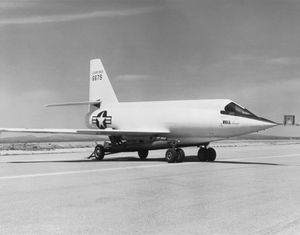
The XLR-25-CW-1 engine would have two combustion chambers in an unusual arrangement. The upper chamber would be eight inches in diameter and would be able to provide thrust up to 5,000 pounds, whereas the lower chamber would have a 12-inch diameter with maximum thrust of 10,000 pounds. Each chamber could be throttled from half up to full thrust, thus the engine was capable of providing thrust ranging from 2,500 to 15,000 pounds; more than twice the XLR11 thrust. Full thrust could be maintained for 175 seconds before running out of propellant, and it could run for 560 seconds at lowest thrust. In spite of its impressive power, the engine, including turbo pump, weighed only 438 pounds. Another unusual design feature was the canting of the two combustion chambers away from each other at a small angle, apparently so that the thrust line of each would line up with the airplane center of gravity to prevent rotating the airplane in pitch . [26, p-.6] [39, p.38, 43]
A number of problems arose in the development of such a compact and powerful engine, and the Air Force and NACA at times considered canceling not only the engine contract but also the entire X-2 project. As it was, the engine fell three years behind its original schedule; with resultant impact on aircraft readiness for flight. [39, p.38,43] [30, p.5]
Flight at Last, and then Disaster
The Air Force assigned tail numbers 46-674 and 46-675 to the two planes, and for brevity, NACA and Bell called them the X-2-1 and X-2-2 respectively. It turned out that the X-2-2 actually came off the assembly floor first, in November 1950, minus its rocket engine. Then it went into eight months of static load testing at the plant; fitted with ballast in the tail in place of the engine. Then it was mated with its B-50 mother plane for captive flights near the plant. After this it was ferried to Edwards AFB for glide flights, still fitted with ballast in place of the engine. Bell then made two captive flights with the X-2-2, followed by a glide flight under the command of Bell pilot Jean “Skip” Ziegler on 27 June 1952. After another glide flight by Skip Ziegler, LCOL Frank K. “Pete” Everest, the primary Air Force project pilot, made one familiarization glide flight. After this, the plane was ferried back to the Bell Plant at Buffalo, NY, where its engine would soon be ready. [36, p.27] [39, p.37]
In March 1953 Bell had the X-2-2 carried aloft over Lake Ontario by its B-50 mother plane, minus its XLR-25 engine, for captive flights to test various systems. On 12 May 1953 the craft was taken up to test the liquid oxygen jettison system, and as the nitrogen pressure in the oxygen tank reached its jettison pressure, the X-2-2 was rocked by a violent explosion that not only tore it loose from the mother plane but also shattered it in pieces. The nearby chase plane was roughly shaken, and the mother plane pushed upward over 100 feet. The chase plane pilot reported the biggest piece of the X-2-2 he saw was one half of one wing panel, and it missed him by about 50 feet. Tragically, both test pilot Skip Ziegler and Bell crew member Frank Wolco were killed. The B-50 pilots were able to land the badly damaged mother plane, but it was unrepairable and a new mother plane had to be readied. [36, pp.31-34]
Bell Aircraft, the Air Force, and NACA convened an accident review board, but had very little to go on other than eyewitness reports. The only X-2 wreckage ever recovered from Lake Ontario was a bucket full of balsa wood that had been used as supports and spacers for various equipment. No other remains have ever been recovered from the lake, and still today amateur searchers with underwater cameras are trying to find the craft’s remains. Bell Aircraft even went to the extent of building an X-2 fuselage complete with engine, tanks and all other equipage to aid the review board. The cause of the explosion was not definitely determined, but the most likely cause was thought to be leaking alcohol vapor that had been ignited by an electrical spark; as in the X-1D explosion. It would take two more years to find the real cause: the preservative in the oxygen system’s leather gaskets. [39, p.38, 211] [30, p.6]
Starting the Research Program
With engine installed, X-2-1 was ferried by B-50 express to Edwards on 15 July 1954. At the NACA hangar, technicians installed the instrumentation suite, heavy on skin thermocouples, structure strain gages, and pressure measurement orifices, as well as the standard control force, control positions, accelerometers, rotation rates, flight conditions, and engine parameters. LCOL Everest made the first glide flight on 5 August, and then the plane was finally ready for powered flight, three years later than originally planned. Everest made the first powered flight on 18 November 1955 using the 5,000 pound-thrust chamber only, and achieved Mach 0.95 and 32,000 feet. Then on 24 March 1956 he used the 10,000 pound chamber to go to Mach 0.91 and 45,000 feet. The X-2’s first supersonic flight would be on 25 April when Everest went to over 50,000 feet and Mach 1.4. He would then make three more powered flights, culminating at Mach 2.87 and 60,000 feet on 23 July. [36, p.36, 38, pp.44-48]
The next X-2 flight was on 25 May, when a new Air Force pilot, CAPT Iven C. Kincheloe, would take the craft to Mach 1.14 in a familiarization flight. After this flight the plane underwent installation of exhaust nozzle extensions on both engine chambers to improve performance for the next phase of testing. [36, p.47] Everest would then make the next two flights, and on his last X-2 flight on 23 July, he made a new unofficial world speed record of Mach 2.87 while gathering aerodynamic heating data. On this flight, LCOL Everest noted that when making roll, pitch and yaw control pulses, the craft seemed relatively well damped and stable in pitch and yaw, but seemed to want to continue rolling even after he centered the stick. He warned that at speeds above Mach 2.9, the plane might not be controllable, as was also indicated by wind tunnel findings. Everest had indeed found that the best way to fly the plane above Mach 2.7 was to lock the rudder, take his hands off the controls, and hang on to a grab bar at the top of the instrument panel. He would let the plane fly itself until fuel exhaustion and deceleration to a safe speed. Any control movement seemed to induce unwanted oscillations or flight divergences, especially at higher angles of attack. [30, pp.7-8] [39, pp.39-41] CAPT Kincheloe then took over for the next three flights, that were to be high altitude attempts. On 7 September he set a new unofficial world’s altitude record of 125,900 feet. This record would not be broken until four years later by the X-15 research airplane. [36, pp.52-53]
Toward Mach 3
NACA and the Air Force had made arrangements to transfer the X-2-1 program to High Speed Flight Station management starting in mid September. Here, NACA engineer were anxious to begin methodical research flights to gather aerodynamic heating and stability and control data between the speeds of Mach 2 and 3 over a range of altitudes. The Air Force, however, asked if one more of their test pilots, CAPT Milburn G. Apt, could make a checkout flight before turnover. NACA agreed and helped prepare a flight profile that would fit in with their planned test series. It was called an "optimum maximum energy flight path". Though a highly experienced engineering test pilot, this would be Apt’s first flight in a rocket propelled research airplane. [44]
In February 1956, CAPT Apt had been assigned to the X-2 project and had flown a chase plane supporting Ivan Kincheloe’s flights. When he learned he was to have the chance to fly the X-2, he intently went over the reports and data records of all past X-2 flights, and spent numerous hours in the analog X-2 flight simulator. He met with NACA stability and control engineering specialists who briefed him on the stability and pilot handling characteristics at speeds above Mach 2.7. They cautioned him not to make any sudden control movements above that speed because shock waves blanketed the tail stabilizing surfaces leaving little or no static restoring tendency. They also told him that if the plane became uncontrollable, he should immediately cut the throttle and drop the nose to a low angle of attack that would put him back into a region of better stability. Apt would also sit in the X-2 cockpit learning all control and switch locations by heart, and memorizing emergency procedures. CAPT Kincheloe also briefed him on all he had learned about the airplane. [38] [36, p.56]
Just after dawn on 27 September 1956, the mother B-50 bearing the X-2-1 lifted off the Edwards AFB runway and made its climb to 31,800 feet where Apt was released and lit both rocket chambers. He quickly outdistanced CAPT Kincheloe who was coaching him from an F-100 chase plane, and his Mach meter went past one at 44,000 feet. He was on the exact planned optimum maximum energy flight path when he leveled off at 72,000 feet with engine still burning at maximum thrust. The plan then called for him to accelerate in a shallow dive until engine burnout, when he should achieve Mach 2.8. [36, pp.55-57] [38]
